Distributed floating series active impedances for power transmission systems
a technology of active impedances and power transmission systems, applied in the direction of electric variable regulation, process and machine control, instruments, etc., can solve the problems of large power systems such as those in the united states and canada, which are of great complexity and can be vulnerable to power disruption events, and existing passive transmission systems generally are not well-suited to controlling power flow, etc., to reduce congestion on existing lines, effectively transmit more power, and optimize transmission system efficiency
- Summary
- Abstract
- Description
- Claims
- Application Information
AI Technical Summary
Benefits of technology
Problems solved by technology
Method used
Image
Examples
Embodiment Construction
[0024]With reference to the drawings, FIG. 1 illustrates a set 20 of power transmission lines composed of three conducting lines 21 supported in a conventional manner by insulators 23 on support towers illustratively shown at 25. Individual transmission lines 21 carry current for each phase of a three-phase power transmission system in a conventional manner, and may operate at high voltages typical of long distance transmission systems, e.g., 138 kV to 750 kV. In accordance with the present invention, an active impedance module 30 is attached to each of the transmission lines 21 preferably, but not necessarily, near to the insulators 23 which support the power lines 21. As discussed further below, the active modules 30 are formed to attach to a power transmission line without requiring any physical modification or break in the power line. As illustrated in FIGS. 1 and 2, the impedance modules 30 preferably are solely supported by the power lines 21 and are neither physically connect...
PUM
| Property | Measurement | Unit |
|---|---|---|
| voltage | aaaaa | aaaaa |
| voltages | aaaaa | aaaaa |
| impedance | aaaaa | aaaaa |
Abstract
Description
Claims
Application Information
 Login to View More
Login to View More - R&D
- Intellectual Property
- Life Sciences
- Materials
- Tech Scout
- Unparalleled Data Quality
- Higher Quality Content
- 60% Fewer Hallucinations
Browse by: Latest US Patents, China's latest patents, Technical Efficacy Thesaurus, Application Domain, Technology Topic, Popular Technical Reports.
© 2025 PatSnap. All rights reserved.Legal|Privacy policy|Modern Slavery Act Transparency Statement|Sitemap|About US| Contact US: help@patsnap.com



